小升初语法复习--数词,连词课件(46张ppt)
文档属性
| 名称 | 小升初语法复习--数词,连词课件(46张ppt) |  | |
| 格式 | zip | ||
| 文件大小 | 2.1MB | ||
| 资源类型 | 教案 | ||
| 版本资源 | 通用版 | ||
| 科目 | 英语 | ||
| 更新时间 | 2020-04-30 07:19:06 | ||
图片预览

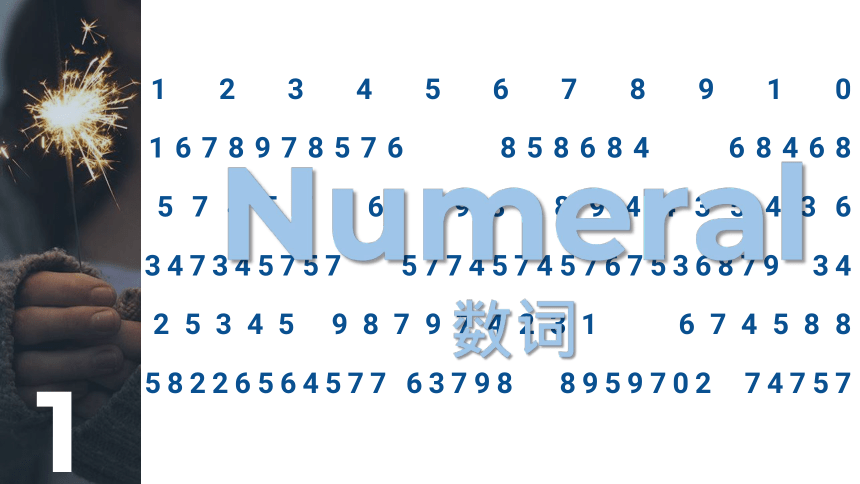
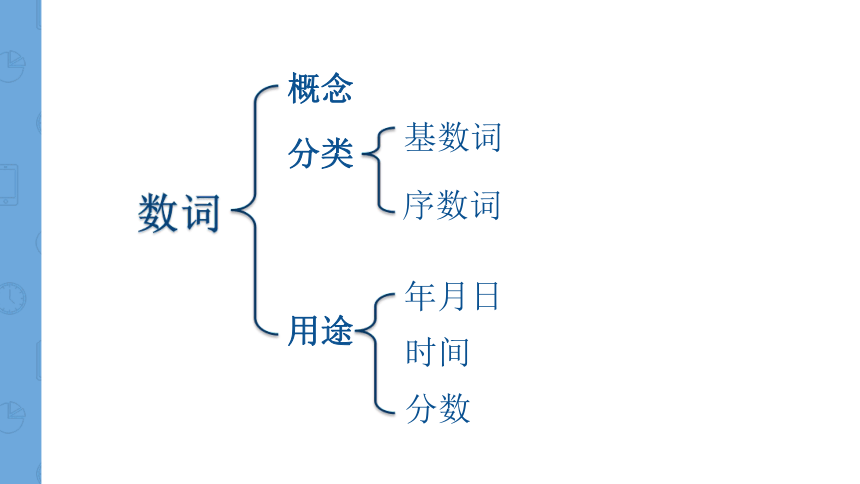
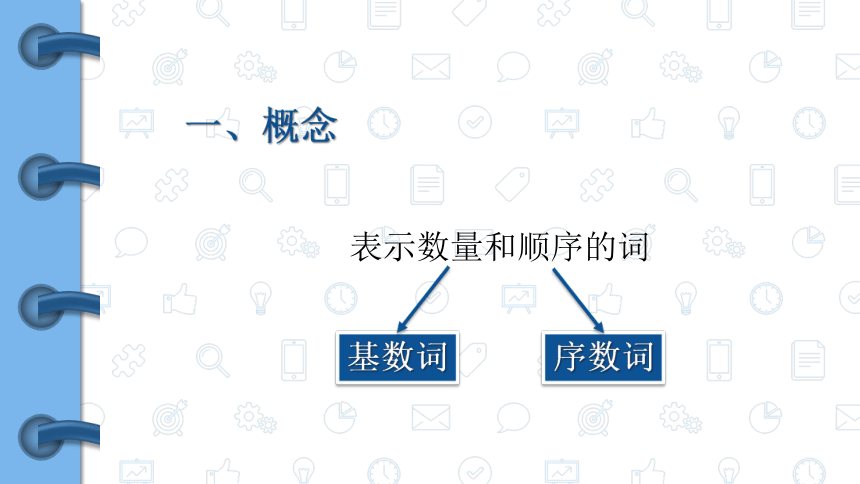
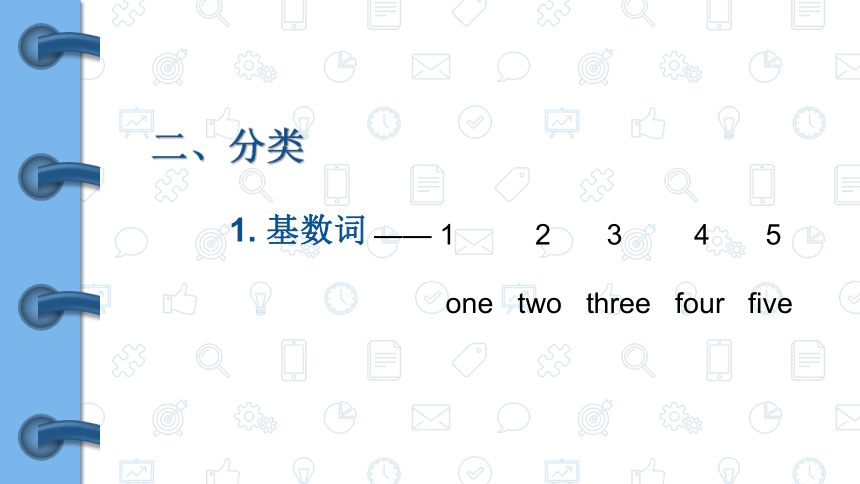
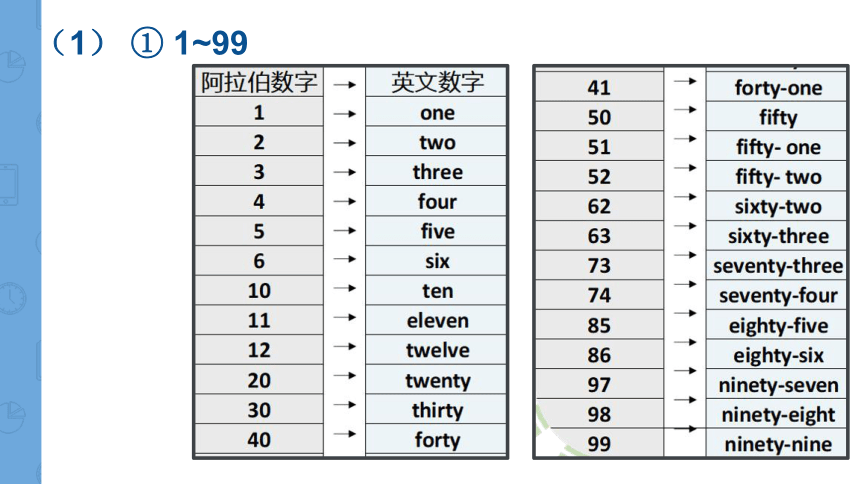
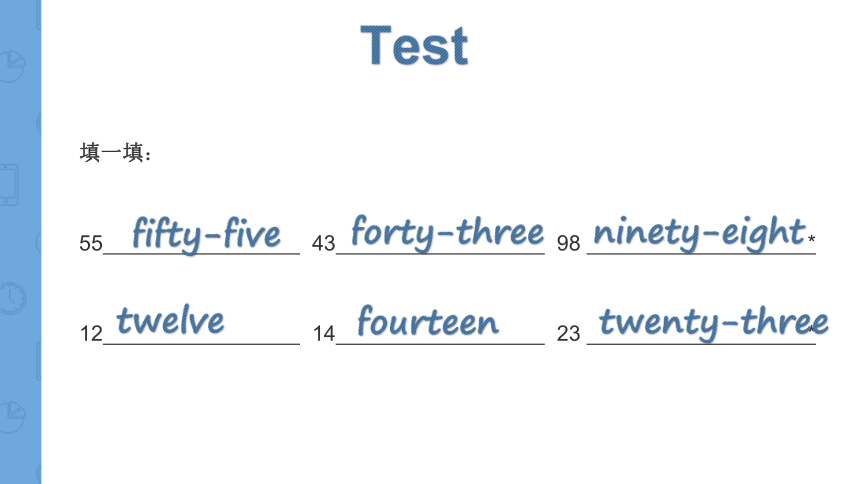
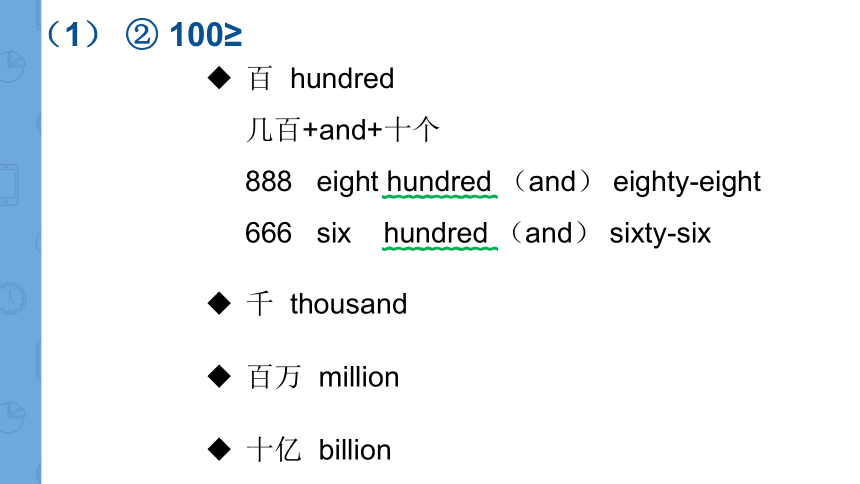

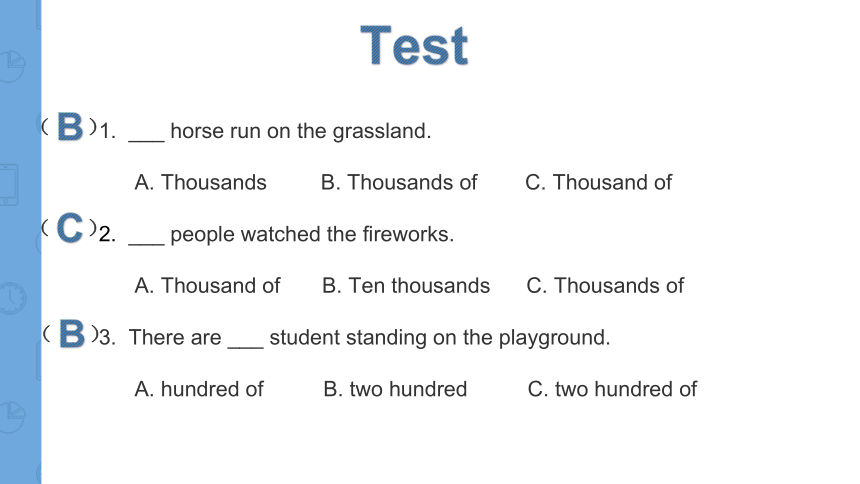
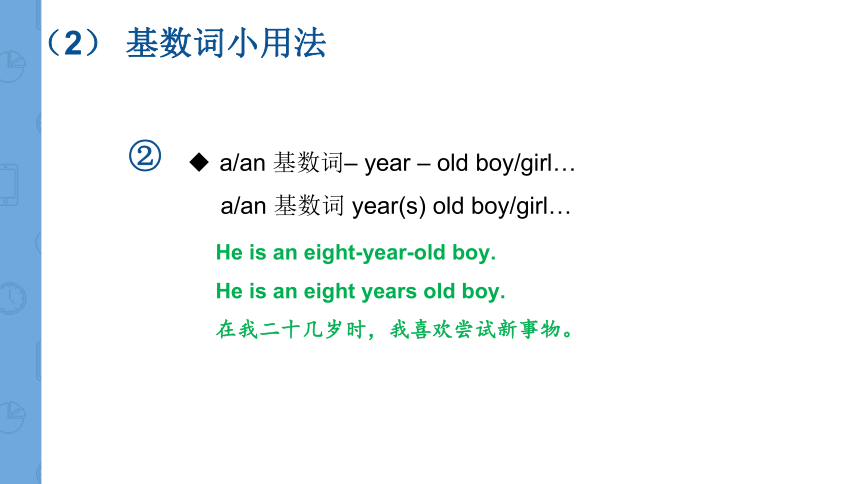
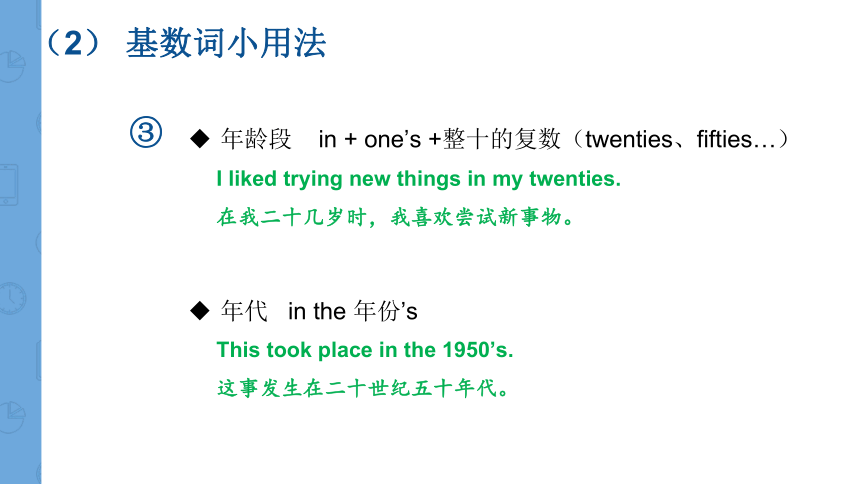
文档简介
(共46张PPT)
Numeral & Conjunction
12345678910
11678978576 858684 68468
25745756 98-894435436
2347345757 57745745767536879 34
325345 987974231 674588
658226564577 63798 8959702 74757
Numeral
数词
1
数词
概念
分类
用途
基数词
序数词
年月日
时间
分数
一、概念
表示数量和顺序的词
基数词
序数词
二、分类
—— 1 2 3 4 5
one two three four five
1. 基数词
(1) ① 1~99
填一填:
55 43 ? 98 *
12 14 23 *
Test
fifty-five
forty-three
ninety-eight
twelve
fourteen
twenty-three
百 hundred
几百+and+十个
888 eight hundred (and) eighty-eight
666 six hundred (and) sixty-six
千 thousand
百万 million
十亿 billion
﹏﹏﹏
﹏﹏﹏
(1) ② 100≥
(2) 基数词小用法
hundreds of
百是计数单位,用单数形式
hundreds of + 可数名词复数 成百上千;数以百计;许多
thousands of
千是计数单位,用单数形式
thousands of +可数名词复数 成千上万;数以千计;许多
The restaurant receives hundreds of tourists every day.
饭店每天接待数以百计的观光客。
This town has thousands of people.
这座城镇有数千人。
①
1. ___ horse run on the grassland.
A. Thousands ?? ? B. Thousands of ?? ?C. Thousand of
___ people watched the fireworks.
A. Thousand of ???B. Ten thousands ?? C. Thousands of
3. There are ___ student standing on the playground.
A. hundred of ? ? ?B. two hundred ??? C. two hundred of
Test
( )
B
( )
C
( )
B
(2) 基数词小用法
a/an 基数词– year – old boy/girl…
a/an 基数词 year(s) old boy/girl…
He is an eight-year-old boy.
He is an eight years old boy.
在我二十几岁时,我喜欢尝试新事物。
②
(2) 基数词小用法
年龄段 in + one’s +整十的复数(twenties、fifties…)
年代 in the 年份’s
I liked trying new things in my twenties.
在我二十几岁时,我喜欢尝试新事物。
This took place in the 1950’s.
这事发生在二十世纪五十年代。
③
二、分类
2. 序数词
—— 1st 2nd 3rd 4th 5th
first second third fourth fifth
基变序,容易记, 加上 th 就可以;
一二三,特殊记, 词尾字母 tdd ;
八减t,九减e, f 来把 ve 替;
若是遇到整十数, ty 变作 tie;
若是遇到几十几, 只变个位就可以。
口诀:
(1) ① 基数词序数词变化
填一填:
55th 43rd ? 98th *
12th 14th 22nd *
1st 44th 20th *
Test
fifty-fifth
forty-third
ninety-eighth
twelfth
fourteenth
twenty-second
first
forty-fourth
twentieth
(2) 序数词小用法
the + 序数词 + 名词
(for) the first time 第一次
(on)the second floor 第二层
Sammy saw rivers for the first time.
Sammy 第一次看见了河流。
The bathroom is on the second floor.
浴室在二楼。
三、用途
基数词 & 序数词的用途
1. 表达日期
月—日—年 日—月—年
2020年4月23日
April 23rd,2020 23rd April,2020
1. Mr. White was born ____.
A. on June 28, 1968 B. in 28 June, 1968
C. in 1968, June 28 D. on June 28 in 1968
Test
( )
A
1. 表达时间
时(基数词)+分(基数词)
分钟 ≤ 30 分(基数词)+ past + 时(基数词)
分钟 > 30 (60 - 分)+ to +(时 + 1) 差…到…点
9:30 nine thirty
10:45 ten forty-five
9:25 (a) quarter past nine
8:17 seventeen past eight
6:30 half past six
9:45 (a) quarter to ten
8:35 twenty-five to nine
Test
3:25
three twenty-five
twenty-five past three
Test
10:45
ten forty-five
fifteen to eleven
= (a) quarter to eleven
1. Mr. White make lunch at ____.
A. seven o’clock B. five thirty
C. half past twelve D. a quarter to eight
Test
( )
C
1. 表达分数
分子 = 1
注意:
分子 > 1
1/3 one third
1/9 one ninth
——分子基数词,分母序数词
2/3 two thirds
5/8 five eighths
3/4 three quarters = three fourths
1/2 one half = a half
1/4 one quarter = a quarter
填一填:(写出下列分数)
4/5 1/2 ? 1/4 *
3/4 ?19/6 *
Test
four fifths
a half
one fourths
(a quarter)
three fourths
(three quarters)
three and one sixths
Conjunction
连词
2
连词
概念
分类
并列连词
从属连词
一、概念
用来连接词语词、短语与短语、句子与句子的虚词叫做连词。连词在句中不能单独做句子成分,一般不重读。
二、连词的分类
并列连词
从属连词
1.
并
列
连
词
(1) and
和;并且
常用于肯定句,表并列关系,前后内容时态结构一致
● 并列单词或短语 > 3 and放在最后一个单词或短语之前
I went to the park and played with my friends yesterday.
我昨天去了公园并且和朋友玩了一会。
There is a banana, two apples, five peaches and a knife on the desk.
桌子上有一个香蕉、两个苹果、五个桃子和一把刀。
①
1.
并
列
连
词
(1) and
然后;只要…就
用于祈使句中,表示动作的延续
Keep moving,and you’ll get what you want.
继续前行,你会得到你想要的。
Go straight, and you’ll find the museum.
直行你就会找到博物馆。
②
1.
并
列
连
词
(2) or
或者
用于否定句和疑问句中,表示选择
I don’t like to play football or basketball.
我不喜欢打篮球或者踢足球。
What would you like to drink, coffee or tea?
你想喝点什么呢,咖啡还是茶?
①
否则;不然
用于祈使句中
②
Don’t drive so fast or you’ll have an accident.
别开这么快,不然你会出车祸的。
1.
并
列
连
词
(3) but
但是
否定转折
Sammy likes sports , but doesn’t like playing football.
Sammy喜欢运动,但是不喜欢踢足球。
Sammy is not a teacher, but a learner.
Sammy不是一个老师,而是一个学生。
1.
并
列
连
词
(4) so +结果
所以;因此;于是
表示结果,不能和 because 连用
Sammy felt tired so she went to bed early.
Sammy觉得很疲惫,于是早早就睡觉了。
Sammy didn’t come, so I went there alone.
Sammy没有来,所以我自己去了。
Because Sammy didn’t come, I went there alone.
因为Sammy没有来,我自己去了。
1.
并
列
连
词
(5) both…and…
两者都;既…又…
Both Beijing and New York have traffic problems.
北京和纽约都有交通问题。
1.
并
列
连
词
(6) either…or…
两者选一;要么…要么…
Either you or he is right.
要么你是对的,要么他是对的。
1.
并
列
连
词
(7) neither…nor…
两者都不;既不…也不…
He can neither read nor write.
他既不能读也不能写。
Neither he nor I broke the window.
既不是他也不是我打破的窗户。
Neither you nor I am right.
他和我都不对
2.
从
属
连
词
(1) that
引导宾语从句,可省略
He says (that) he has told her the thing.
他说他告诉了她这件事。
2.
从
属
连
词
(2) when
引导时间状语从句, 当…的时候
It was raining, when I arrived.
当我到达的时候,正在下雨。
2.
从
属
连
词
(3) till / until
引导时间状语从句, 直到…的时候
We won’t leave until you arrive.
你来之前我不会走的。
They worked till midnight.
他们工作到半夜。
2.
从
属
连
词
(4) before & after
引导时间状语从句, before 在….之前, after 在 …之后
I have to finish my homework before class.
我必须在上课前完成我的作业。
We all missed you after you left.
你离开之后,我们都很想你。。
2.
从
属
连
词
(5) because +原因
引导原因状语从句, 因为
The water wastes because they often forget to turn off the tap.
因为他们经常忘记关水龙头,所以废水。
I can’t do it now because I am busy.
因为我正忙着,现在不能做此事。
2.
从
属
连
词
(6) if
引导条件状语从句, 如果
If you like it, do it.
如果你喜欢,就行动起来吧。
If we work hard we can pass the exam.
如果我们努力我们可以通过考试。
I wanted to fly a kite _______________ I didn’t have one.
A. so B. but C. that D. until
Test
( )
B
2. Sammy falls down from the bike _______ she need to see a doctor.
A. so B. but C. or D. because
( )
A
Hold it tight,______________ you’ll lose it.
A. so B. but C. or D. because
( )
C
4. Lily and Sammy are students. ___________ Lily___________ Sammy is teacher.
A. so ; that B. either…or… C. neither…nor…
( )
C
5. Jim is tired, _______________ he stayed up late.
A. so B. but C. or D. because
Test
( )
D
6. Sammy keep running _________ she break the record.
A. until B. and C. but D. if
( )
A
7. Think twice_________ you take the actions.
A. after B. though C. before D. until
( )
C
8. Study hard, ___________ you won’t catch up with your friends.
A. but B. or C. and D. so
( )
B
Numeral & Conjunction
12345678910
11678978576 858684 68468
25745756 98-894435436
2347345757 57745745767536879 34
325345 987974231 674588
658226564577 63798 8959702 74757
Numeral
数词
1
数词
概念
分类
用途
基数词
序数词
年月日
时间
分数
一、概念
表示数量和顺序的词
基数词
序数词
二、分类
—— 1 2 3 4 5
one two three four five
1. 基数词
(1) ① 1~99
填一填:
55 43 ? 98 *
12 14 23 *
Test
fifty-five
forty-three
ninety-eight
twelve
fourteen
twenty-three
百 hundred
几百+and+十个
888 eight hundred (and) eighty-eight
666 six hundred (and) sixty-six
千 thousand
百万 million
十亿 billion
﹏﹏﹏
﹏﹏﹏
(1) ② 100≥
(2) 基数词小用法
hundreds of
百是计数单位,用单数形式
hundreds of + 可数名词复数 成百上千;数以百计;许多
thousands of
千是计数单位,用单数形式
thousands of +可数名词复数 成千上万;数以千计;许多
The restaurant receives hundreds of tourists every day.
饭店每天接待数以百计的观光客。
This town has thousands of people.
这座城镇有数千人。
①
1. ___ horse run on the grassland.
A. Thousands ?? ? B. Thousands of ?? ?C. Thousand of
___ people watched the fireworks.
A. Thousand of ???B. Ten thousands ?? C. Thousands of
3. There are ___ student standing on the playground.
A. hundred of ? ? ?B. two hundred ??? C. two hundred of
Test
( )
B
( )
C
( )
B
(2) 基数词小用法
a/an 基数词– year – old boy/girl…
a/an 基数词 year(s) old boy/girl…
He is an eight-year-old boy.
He is an eight years old boy.
在我二十几岁时,我喜欢尝试新事物。
②
(2) 基数词小用法
年龄段 in + one’s +整十的复数(twenties、fifties…)
年代 in the 年份’s
I liked trying new things in my twenties.
在我二十几岁时,我喜欢尝试新事物。
This took place in the 1950’s.
这事发生在二十世纪五十年代。
③
二、分类
2. 序数词
—— 1st 2nd 3rd 4th 5th
first second third fourth fifth
基变序,容易记, 加上 th 就可以;
一二三,特殊记, 词尾字母 tdd ;
八减t,九减e, f 来把 ve 替;
若是遇到整十数, ty 变作 tie;
若是遇到几十几, 只变个位就可以。
口诀:
(1) ① 基数词序数词变化
填一填:
55th 43rd ? 98th *
12th 14th 22nd *
1st 44th 20th *
Test
fifty-fifth
forty-third
ninety-eighth
twelfth
fourteenth
twenty-second
first
forty-fourth
twentieth
(2) 序数词小用法
the + 序数词 + 名词
(for) the first time 第一次
(on)the second floor 第二层
Sammy saw rivers for the first time.
Sammy 第一次看见了河流。
The bathroom is on the second floor.
浴室在二楼。
三、用途
基数词 & 序数词的用途
1. 表达日期
月—日—年 日—月—年
2020年4月23日
April 23rd,2020 23rd April,2020
1. Mr. White was born ____.
A. on June 28, 1968 B. in 28 June, 1968
C. in 1968, June 28 D. on June 28 in 1968
Test
( )
A
1. 表达时间
时(基数词)+分(基数词)
分钟 ≤ 30 分(基数词)+ past + 时(基数词)
分钟 > 30 (60 - 分)+ to +(时 + 1) 差…到…点
9:30 nine thirty
10:45 ten forty-five
9:25 (a) quarter past nine
8:17 seventeen past eight
6:30 half past six
9:45 (a) quarter to ten
8:35 twenty-five to nine
Test
3:25
three twenty-five
twenty-five past three
Test
10:45
ten forty-five
fifteen to eleven
= (a) quarter to eleven
1. Mr. White make lunch at ____.
A. seven o’clock B. five thirty
C. half past twelve D. a quarter to eight
Test
( )
C
1. 表达分数
分子 = 1
注意:
分子 > 1
1/3 one third
1/9 one ninth
——分子基数词,分母序数词
2/3 two thirds
5/8 five eighths
3/4 three quarters = three fourths
1/2 one half = a half
1/4 one quarter = a quarter
填一填:(写出下列分数)
4/5 1/2 ? 1/4 *
3/4 ?19/6 *
Test
four fifths
a half
one fourths
(a quarter)
three fourths
(three quarters)
three and one sixths
Conjunction
连词
2
连词
概念
分类
并列连词
从属连词
一、概念
用来连接词语词、短语与短语、句子与句子的虚词叫做连词。连词在句中不能单独做句子成分,一般不重读。
二、连词的分类
并列连词
从属连词
1.
并
列
连
词
(1) and
和;并且
常用于肯定句,表并列关系,前后内容时态结构一致
● 并列单词或短语 > 3 and放在最后一个单词或短语之前
I went to the park and played with my friends yesterday.
我昨天去了公园并且和朋友玩了一会。
There is a banana, two apples, five peaches and a knife on the desk.
桌子上有一个香蕉、两个苹果、五个桃子和一把刀。
①
1.
并
列
连
词
(1) and
然后;只要…就
用于祈使句中,表示动作的延续
Keep moving,and you’ll get what you want.
继续前行,你会得到你想要的。
Go straight, and you’ll find the museum.
直行你就会找到博物馆。
②
1.
并
列
连
词
(2) or
或者
用于否定句和疑问句中,表示选择
I don’t like to play football or basketball.
我不喜欢打篮球或者踢足球。
What would you like to drink, coffee or tea?
你想喝点什么呢,咖啡还是茶?
①
否则;不然
用于祈使句中
②
Don’t drive so fast or you’ll have an accident.
别开这么快,不然你会出车祸的。
1.
并
列
连
词
(3) but
但是
否定转折
Sammy likes sports , but doesn’t like playing football.
Sammy喜欢运动,但是不喜欢踢足球。
Sammy is not a teacher, but a learner.
Sammy不是一个老师,而是一个学生。
1.
并
列
连
词
(4) so +结果
所以;因此;于是
表示结果,不能和 because 连用
Sammy felt tired so she went to bed early.
Sammy觉得很疲惫,于是早早就睡觉了。
Sammy didn’t come, so I went there alone.
Sammy没有来,所以我自己去了。
Because Sammy didn’t come, I went there alone.
因为Sammy没有来,我自己去了。
1.
并
列
连
词
(5) both…and…
两者都;既…又…
Both Beijing and New York have traffic problems.
北京和纽约都有交通问题。
1.
并
列
连
词
(6) either…or…
两者选一;要么…要么…
Either you or he is right.
要么你是对的,要么他是对的。
1.
并
列
连
词
(7) neither…nor…
两者都不;既不…也不…
He can neither read nor write.
他既不能读也不能写。
Neither he nor I broke the window.
既不是他也不是我打破的窗户。
Neither you nor I am right.
他和我都不对
2.
从
属
连
词
(1) that
引导宾语从句,可省略
He says (that) he has told her the thing.
他说他告诉了她这件事。
2.
从
属
连
词
(2) when
引导时间状语从句, 当…的时候
It was raining, when I arrived.
当我到达的时候,正在下雨。
2.
从
属
连
词
(3) till / until
引导时间状语从句, 直到…的时候
We won’t leave until you arrive.
你来之前我不会走的。
They worked till midnight.
他们工作到半夜。
2.
从
属
连
词
(4) before & after
引导时间状语从句, before 在….之前, after 在 …之后
I have to finish my homework before class.
我必须在上课前完成我的作业。
We all missed you after you left.
你离开之后,我们都很想你。。
2.
从
属
连
词
(5) because +原因
引导原因状语从句, 因为
The water wastes because they often forget to turn off the tap.
因为他们经常忘记关水龙头,所以废水。
I can’t do it now because I am busy.
因为我正忙着,现在不能做此事。
2.
从
属
连
词
(6) if
引导条件状语从句, 如果
If you like it, do it.
如果你喜欢,就行动起来吧。
If we work hard we can pass the exam.
如果我们努力我们可以通过考试。
I wanted to fly a kite _______________ I didn’t have one.
A. so B. but C. that D. until
Test
( )
B
2. Sammy falls down from the bike _______ she need to see a doctor.
A. so B. but C. or D. because
( )
A
Hold it tight,______________ you’ll lose it.
A. so B. but C. or D. because
( )
C
4. Lily and Sammy are students. ___________ Lily___________ Sammy is teacher.
A. so ; that B. either…or… C. neither…nor…
( )
C
5. Jim is tired, _______________ he stayed up late.
A. so B. but C. or D. because
Test
( )
D
6. Sammy keep running _________ she break the record.
A. until B. and C. but D. if
( )
A
7. Think twice_________ you take the actions.
A. after B. though C. before D. until
( )
C
8. Study hard, ___________ you won’t catch up with your friends.
A. but B. or C. and D. so
( )
B
